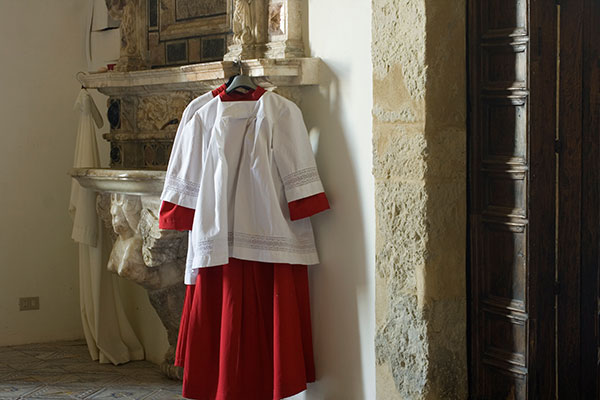 Star of the Sea Parish on San Francisco caused a minor kerfuffle when it made the decision to return to a boys-only policy for altar service. Girls who currently serve the Mass will be allowed to continue; henceforth, only boys will be trained for these duties.
Star of the Sea Parish on San Francisco caused a minor kerfuffle when it made the decision to return to a boys-only policy for altar service. Girls who currently serve the Mass will be allowed to continue; henceforth, only boys will be trained for these duties.
Altar girls have been allowed since 1994. Since then the number boys serving at the altar has plummeted. Nationally, the priest shortage has gone from a nuisance to a full-blown crisis.
Fr. Joseph Illo of Star of the Sea explained his decision in this statement. He cited two reasons for the decision:
1) In a mixed altar-server program, boys usually end up losing interest, because girls generally do a better job.
2) Altar service is intrinsically tied to the priesthood and serves as feeder programs for the seminary. Since the Catholic Church does not ordain women, altar girls may distract men from the pursuit of a priestly vocation.
Of course, the reaction from the press was swift and virulent. As expected, the media saw this move through its favorite lens: men oppressing women. The Huffington Post went so far as to label the decision an “altar girl scandal.” Some parishioners expressed their outrage by quitting the church (after all, this is California).
The public reaction to the decision reflects a profound lack of interest in the spiritual lives of boys. Critics of the decision have not offered any alternative solutions to address the disinterest of young men. Their attitude seems to be: Boys have a problem with altar girls? So what? Better to weed these misogynistic oppressors out of the church now – or teach them that the era of male privilege is over. Besides, if girls are better servers at the altar, then why not go all the way and ordain women?
Feminism has done such a good job casting women as victims that society sees any attempt to foster masculine development as an outright attack on women. So conditioned are we to protect women from even the slightest breeze of sexism that we seem paralyzed when it comes to helping males.
So why is the presence of altar girls disheartening to boys in the first place? It has to do with the way boys become men. I explain this process in great detail in Why Men Hate Going to Church. Here’s a very quick summary:
Psychologically healthy boys undergo a process called separation-individuation, in which they emotionally detach from their mother and all things female. This process begins around age seven, when girls suddenly develop “cooties” and boys begin to hew to culturally prescribed masculine behaviors. Throughout their lives men instinctively avoid anything that’s woman-oriented — baby showers, fabric stores and Pinterest are but a few examples.
Few women understand this need in men, because they never undergo separation-individuation. Whereas most little boys are raised in a world dominated by women and female values, little girls are rarely raised in a world dominated by men and their values.
As a result, women spend their lives fascinated by the things of men, whereas men are utterly bored by the things of women.
This divergence is at the heart of the altar girl controversy. Girls were excited to begin serving at the altar back in the ‘90s. But once girls became the majority (and performed so well) boys began losing interest. So more girls stepped forward. Eventually altar service became a female-dominated activity. At this point no self-respecting boy wanted to have anything to do with the altar because it was seen as something that girls did.
Star of the Sea also noted that girls generally did a better job than boys – which further discouraged boys from serving. Boys are intensely competitive. Once a male realizes he’s no good at something (or a girl is better than he is) he often feels like quitting.
Now, I wish men weren’t this way. But it’s reality – particularly for many adolescent boys.
Want to know why men hate going to church? Even though the pastor is probably a man, women dominate church culture. The church office is likely to be staffed entirely by women. The bulk of volunteers and ministry leaders are usually women. Without realizing it, these women create a culture that suits their needs and plays to their strengths. Men who try to participate beyond weekly worship realize very quickly that women are just better at doing church than they are – so they feel unwanted and unneeded in church.
I know – some of you must be gagging at the idea that men could feel marginalized in a male-dominated culture such as Catholicism. But, as Catholic scholar Leon Podles put it, “The Church is an army of women led by a few male generals.” Just because certain males control the altar and pulpit, do not assume that the average man in the pew feels equally empowered.
Those of you with liberal leanings may instinctively see Star of the Sea’s decision as an open-and-shut case of discrimination. But read the priest’s letter of explanation. Consider why he made this difficult decision. At its heart, the all-male program is a textbook case of affirmative action, targeted at Christianity’s largest minority group. It’s creating a safe space for this underperforming population (boys) to participate without being outperformed by the majority (girls).
If we are to engage more men in church, we need to give them sacred roles they can call their own. Boys need to know from a very early age that church is something for them. Otherwise they will happily yield the religious space to women. As the men withdraw, the church dies. Doubt me? Just look at the Episcopal Church.
For an excellent article that shows the impact of altar girls on boys’ participation, click here.
 David Murrow is the author of the bestselling book, Why Men Hate Going to Church. David’s books have sold more than 175,000 copies in 12 languages. He speaks to groups around the world about Christianity’s persistent gender gap. He lives in Alaska with his wife of more than 30 years, professional silk artist Gina Murrow. Learn more about David at his Web site, www.churchformen.com, or join the conversation on his Facebook page, www.facebook.com/churchformen. Don’t forget to share this page by clicking on the links below, or scroll down and leave a comment (right below those annoying ads that pay for this blog).
David Murrow is the author of the bestselling book, Why Men Hate Going to Church. David’s books have sold more than 175,000 copies in 12 languages. He speaks to groups around the world about Christianity’s persistent gender gap. He lives in Alaska with his wife of more than 30 years, professional silk artist Gina Murrow. Learn more about David at his Web site, www.churchformen.com, or join the conversation on his Facebook page, www.facebook.com/churchformen. Don’t forget to share this page by clicking on the links below, or scroll down and leave a comment (right below those annoying ads that pay for this blog).
















